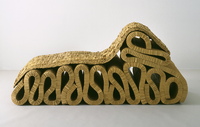Bubbles Chaise Longue
Gehry, Frank Owen

Download104310_cp.jpg (559.5Kb)
Date
1987Description
Gehry worked with an unexpected, throwaway material—corrugated cardboard—in two series of surprisingly sturdy and humorous home furnishings. The instant success of the first series, Easy Edges, introduced in 1972, earned him national recognition. Gehry conceived its cardboard tables, chairs, bed frames, rocking chairs, and other items to suit the homes of young as well as old, of urban sophisticates as well as country dwellers. The Bubbles Chaise Longue belongs to Experimental Edges, the second series, which was introduced in 1979. These objects were intended to be artworks; yet they are sturdy enough for regular use. As the cardboard wears, it begins to appear suedelike and soft. Gehry's material lends itself to the curving form of this chair; its rollicking folds are, perhaps, a play on the corrugations themselves.
Heavily marketed and intentionally inexpensive, this furniture epitomized Gehry's interest in promoting affordable good design. The choice of "lowbrow" cardboard for Bubbles reflects Gehry's broad interest in using industrial, commercial, and utilitarian materials. An award-winning architect, he has worked with exposed chainlink fencing, corrugated metal, and plywood in concurrent architectural projects. In both the furniture series and the buildings, Gehry has given value to seemingly worthless materials by using them to create lasting designs.
The Museum of Modern Art, MoMA Highlights, New York: The Museum of Modern Art, revised 2004, originally published 1999, p. 318 full view
Type of Work
Chaise longueSubject
Furniture, Design, Industrial, Seating, Cardboard, Decorative arts
Rights
Rights Statement
Licensed for educational and research use by the MIT community only
Item is Part of
133819